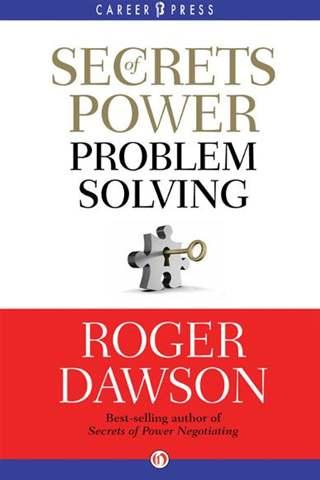Recommended Resource – Secrets of Power Problem Solving
Secrets of Power Problem Solving
by Roger Dawson
About the Reference
Secrets of Power Problem Solving by Roger Dawson provides an insightful examination of the theories and practices associated with decision-making. Throughout his book, Roger challenges commonly held beliefs about the decision-making process and provides actionable methods to effectively address problems of all types… of which he indicates there are only two, people and money issues.
In Secrets of Power Problem Solving, Roger presents methods for answering several key decision-making questions:
- Does the Problem Deserve a Solution?
- Is the Problem Real or Imagined?
- How Quickly Should You Choose?
- Intuition or Rapid Reasoning?
- What Makes You a Great Problem Solver?
Benefits of Using this Reference
StrategyDriven Contributors like Secrets of Power Problem Solving because of its logical, well-structured approach to everyday decision-making that will be of value to new and seasoned professionals. Roger provides immediately implementable methods for effectively dealing with both people and money challenges. Furthermore, each chapter is summarized by a “Key points from this chapter” list that makes periodic review of his book for principles reinforcement easy and fast.
If we had one suggestion to offer it would be that the flow of the book and its recommendations would be more easily synthesized by the reader if an overview of the decision-making process was presented in the beginning of the book. This is a very minor point as a moderately experienced decision-maker can easily follow Roger’s line of thinking throughout the book.
Effective decision-making is both a role and challenge for today’s professionals. Secrets of Power Problem Solving’s methods provide new and seasoned professionals with a collection of decision-making practices that will help them become better decision-makers. Additionally, the recommendations Roger presents throughout his book are very well aligned with StrategyDriven’s decision-making best practices; making Secrets of Power Problem Solving a StrategyDriven recommended read.


 Since growing up in his family’s boating business to founding his company CMI, Bruce Hodes has dedicated himself to helping companies grow by developing executive leadership teams, business leaders and executives into powerful performers. Bruce’s adaptable Breakthrough Strategic Business Planning methodology has been specifically designed for small-to-mid-sized companies and is especially valuable for family company challenges. In February of 2012 Bruce published his first book
Since growing up in his family’s boating business to founding his company CMI, Bruce Hodes has dedicated himself to helping companies grow by developing executive leadership teams, business leaders and executives into powerful performers. Bruce’s adaptable Breakthrough Strategic Business Planning methodology has been specifically designed for small-to-mid-sized companies and is especially valuable for family company challenges. In February of 2012 Bruce published his first book  Since growing up in his family’s boating business to founding his company CMI, Bruce Hodes has dedicated himself to helping companies grow by developing executive leadership teams, business leaders and executives into powerful performers. Bruce’s adaptable Breakthrough Strategic Business Planning methodology has been specifically designed for small-to-mid-sized companies and is especially valuable for family company challenges. In February of 2012 Bruce published his first book
Since growing up in his family’s boating business to founding his company CMI, Bruce Hodes has dedicated himself to helping companies grow by developing executive leadership teams, business leaders and executives into powerful performers. Bruce’s adaptable Breakthrough Strategic Business Planning methodology has been specifically designed for small-to-mid-sized companies and is especially valuable for family company challenges. In February of 2012 Bruce published his first book  All organizations face resource constraints inhibiting the accomplishment of all proposed work. Some organizations resist prioritizing initiatives commonly resulting in the completion of lower value activities ahead of those with a higher return on investment. Such an approach diminishes the value returned to stakeholders and represents an abdication of management’s responsibilities.
All organizations face resource constraints inhibiting the accomplishment of all proposed work. Some organizations resist prioritizing initiatives commonly resulting in the completion of lower value activities ahead of those with a higher return on investment. Such an approach diminishes the value returned to stakeholders and represents an abdication of management’s responsibilities. Establishing and maintaining and organizational culture supportive of a diverse and inclusive workforce requires deliberate ongoing action communicating the importance of and support for these principles. Consequently, leaders need insight into employee behaviors such that appropriate corrective actions can be taken when necessary as well as visibly reinforcing their commitment to the principles of organizational diversity and inclusiveness. Helping achieve both these goals is a robust performance measurement system specifically tailored to measure the organization’s commitment to being diverse and inclusive.
Establishing and maintaining and organizational culture supportive of a diverse and inclusive workforce requires deliberate ongoing action communicating the importance of and support for these principles. Consequently, leaders need insight into employee behaviors such that appropriate corrective actions can be taken when necessary as well as visibly reinforcing their commitment to the principles of organizational diversity and inclusiveness. Helping achieve both these goals is a robust performance measurement system specifically tailored to measure the organization’s commitment to being diverse and inclusive.